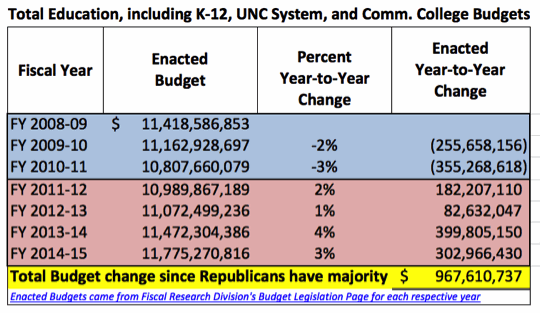It is an election year, and that means our televisions and radio are littered with campaign ads. Advertisements try to persuade you to vote for candidates based upon their morals, past experience, community involvement, and ability to influence or pass legislation. Or they attack with a sensational fact designed to make you think poorly of an opponent as a candidate. I am not here to tell you who to vote for, but I do want to shed some light on an ad that I’ve seen that doesn’t get the facts right regarding the North Carolina budget.
Incumbent Senator Kay Hagan is running against Speaker of the House Thom Tillis for US Senate, and the race has garnered national attention. Television commercials from Women Vote, an arm of EMILY’s List, and the National Education Association Advocacy Fund claim Tillis cut education spending by $500 million.
If you watch the commercials, they are both focused around elementary school teachers and students, so naturally you think the budget figure they are referring to is a cut in K-12 education. That is incorrect; they are talking about ALL education spending in the state, which includes K-12 education as well as the University System and the Community College System.
Another thing to remember, they are only looking at the state’s General Fund, so that does not include any spending on education from the federal government, local governments, lottery dollars, grants, or any of the other multiple revenue sources that fund education in North Carolina.
So where does the $500 million figure come from? Each year the state budget writers create a continuation budget, but it is not a real spending figure. Rather, it is simply a calculated amount based upon prior year actual spending, requested increases from state agencies, adjustments for inflation, mandatory rate increases, and expected operation costs of new facilities. The $500 million figure is the continuation budget minus the enacted budget voted on in the legislature.
The problem with this calculation is that these two budget figures do not measure the same thing. The State’s budget law mandates a transfer of funds to occur after the budget is signed into law, and this transferred money pays for salary increases, retirement benefits, and health care benefits for state employees. The enacted budget at the agency level does not include the whole amount spent, because it doesn’t include those elements. Since the continuation budget includes the previous year’s actual spending amount, it does include all of those pieces. This causes the continuation budget figure to be inflated by the reserve transfer amount when compared to the enacted budget. A historical evaluation shows that the continuation budget has been higher than actual spending for all three areas of education (K-12, UNC System, and Community Colleges) during the last four years.
The simple explanation is that the $500 million figure is essentially an apples-to-oranges comparison. I have collected the enacted budget figures from the last seven years. I chose this timeframe to include data from the last recession. The state budget had to be cut during this time to reflect a decrease in tax revenue to the state, so I thought this would give a truer picture of what has happened with education spending in North Carolina. The commercials say, "Speaker Thom Tillis cut almost $500 million from education." Thom Tillis has been speaker since the 2011-2012 fiscal year, when the first budget was passed under his leadership, until the most recent budget that was passed in the 2014-2015 fiscal year. If we look at all the budgets under his leadership, total education spending increased by nearly $1 billion, if we look at the most recent budget cycle, it increased by a little over $700 million.
The enacted budgets show a clear cut during the recession, which occurred across the country for many states in response to considerable unemployment and lack of state revenue. Since the Republicans took control of the legislature, overall spending in education has increased every year.
There are many arguments one might make about this finding, such as that spending had to increase due to the cuts that took place during the recession or that the spending increases that did take place were not used in the most effective way. Those arguments may be valid, but I am not trying to open new arguments, only to present the facts. When you use the same type of budget data year-after-year and compare spending levels, it is clear that there were no cuts to education spending in North Carolina.
So, did Thom Tillis cut education spending by $500 million? No, that is false. These advertisements are misleading voters, and in the information age we live in today, it is unacceptable to be promoting a fact about a candidate that is false when the data is so easily accessible.
Click here for the Fiscal Update archive.
You can unsubscribe to this and all future e-mails from the John Locke Foundation by clicking the "Manage Subscriptions" button at the top of this newsletter.


